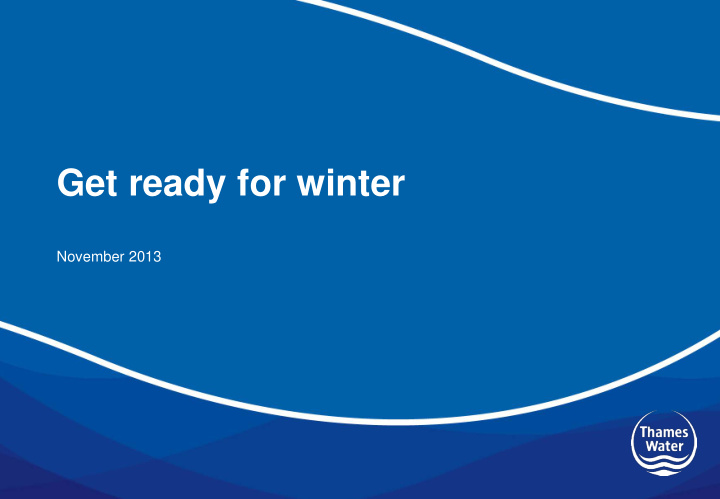



Get ready for winter November 2013
Reduce your risk this winter This pack includes advice to protect you, your team and your site this winter. 1. Your health and wellbeing 2. Zero degrees, zero compromise 3. Winter-proof yourself 4. Winter-proof your surroundings 5. Staying safe on the roads
Your health and wellbeing • Make sure you wrap up warm • Hypothermia occurs when body heat is lost faster than it can be produced. Frostbite and immersion foot can occur at only moderately low temperatures, although prolonged exposure to cold is normally a factor. Both hypothermia and frostbite can kill.
Zero degrees, zero compromise • Over the last five years we’ve seen a six per cent increase in injuries and a 22 per cent increase in lost time injuries between October and March when compared with April to September. • Lower temperatures affect concentration – resulting in increased incidents and injuries. Be aware of how the cold is affecting you and take regular breaks to keep warm.
Winter proof yourself • You must have the right PPE to keep safe while working. Make sure you have what you need and speak to your manager if you don’t. • Consider wearing a winter liner under your hard hat to avoid heat loss, or overshoe grips to avoid slipping (pictured). • Keep your clothing clean as dirt reduces its insulating properties. • Wear gloves whilst handling chemicals - liquids that evaporate quickly such as petrol, alcohol, anti-freeze and ether are particularly hazardous in cold weather as they take heat out of your skin as they evaporate.
Winter proof yourself • Whether you work on a construction site or not, take a good look around your working area, pedestrian walkways and car parks to check they are well lit and report any lighting that isn’t working properly. Make sure we have the right working conditions and there aren’t any hazards that could be hidden by shadows. • Check there is a sufficient supply of grit available to keep paths and roadways safe. • Erect wind screens or protective tents around your site to keep the cold out where possible. • Check emergency showers to make sure they are working, not leaking, and not frozen. If the weather is freezing ensure the header tank is full and the shower is working before accepting a chemical delivery. • Check outdoor first aid boxes contain a thermal blanket in case of emergency. • Ensure your site provides heated welfare facilities, with facilities for storing, drying and changing clothes, as well as to make hot drinks.
Staying safe on the roads • Take care on the roads. Whether you’re a cyclist or driver take a look at our top tips to keep you safe on the roads (available on the Health and Safety Hub). • Fully charge your mobile phone in case you get stuck and save important numbers, including a contact who can help if you are involved in an incident or get a puncture • Check the treads and pressure of your tyres • Tell someone where you’re going and when you expect to arrive. Agree to call them to confirm you’ve arrived safely on long journeys • If the weather is really bad, consider whether you need to make the journey at all. Could you have a conference call instead of travelling? • Reduce your speed and allow yourself extra stopping distance between you and the car in front.
Recommend
More recommend